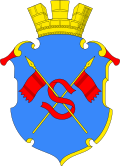Top Qs
Timeline
Chat
Perspective
Sortavala
Town in the Republic of Karelia, Russia From Wikipedia, the free encyclopedia
Remove ads
Sortavala (Russian: Сортавала; Finnish and Karelian: Sortavala; Swedish: Sordavala), previously known as Serdobol (Сердоболь) until 1918, is a town in the Republic of Karelia, Russia, located at the northern tip of Lake Ladoga near the Finnish border, 246 kilometres (153 mi) west of Petrozavodsk, the capital city of the Republic of Karelia. The closest city on the Finnish side of the border is Joensuu, which is located 136 kilometres (85 mi) from Sortavala. In 2021, the population of Sortavala was 19,215.[6]
Remove ads
History
Summarize
Perspective
The district of Sortavala was first recorded in Swedish documents dating to 1468. Russian documents first mention it as Serdovol or Serdobol in 1500. It was ceded to Sweden after the Ingrian War.
With the 1721 Treaty of Nystad, the settlement was joined to Russia along with the rest of Old Finland and was given the Russian name Serdobol. It became known for its marble and granite quarries which provided materials necessary for construction of imperial palaces in St. Petersburg and its neighborhood. In 1812, along with the rest of Viipuri Province, it was joined to the newly formed Grand Duchy of Finland.
In 1917, the town remained a part of independent Finland. It suffered extensively from mass Soviet bombardment during the Winter War,[7] and through the Moscow Peace Treaty Finland was forced to cede the town to the Soviet Union. All of the population of the town was evacuated for the first time. Like the rest of Finnish Karelia, Sortavala was retaken by Finland during 1941–1944 (the period of the Continuation War) and most evacuees returned to rebuild their homes. However, after the armistice of 1944, the Finns were evacuated again and the town was ceded back empty of population. After the war, the town was resettled by the Russian and Karelian population.
Until 1940, the Ladoga shore southwest of Sortavala had been one of the very few relatively densely populated areas north of the Karelian Isthmus populated by Karelians.
Remove ads
Geography
Features
- Paasonvuori, 79.2 m. hill near Sortavala
Climate
Remove ads
Administrative and municipal status
Within the framework of administrative divisions, it is, together with two urban-type settlements and forty-seven rural localities, incorporated as the town of republic significance of Sortavala—an administrative unit with the status equal to that of the districts.[1] As a municipal division, the town of republic significance of Sortavala is incorporated as Sortavalsky Municipal District; the town of Sortavala and ten rural localities are incorporated within it as Sortavalskoye Urban Settlement.[3] The remaining urban-type settlements and rural localities are incorporated within the municipal district into two urban settlements and two rural settlements.[8]

Transportation
Sortavala is a railway station on the Khiytola-Matkaselkä railway.
Layout and development
Summarize
Perspective
Architecture
The central part of the city consists mainly of stone 3-4-storey buildings built at the beginning of the XX century (until the 1930s). As a rule, these are buildings in the style of Northern Art Nouveau (national Romanticism), neoclassicism, the most recent — functionalism, their authors are the most famous Finnish architects Uno Werner Ullberg, Gottlieb Eliel Saarinen, Johan Jacob Arenberg, etc. In addition, a large number of wooden buildings built in the middle of the XIX century, usually in the Empire style, have been preserved. The most notable buildings are:[9]
- The building of the Bank of Finland (arch. Uno Ulberg, 1915)
- The building of the United Bank of the Nordic Countries (architect firm GLS, 1905)
- Lyceum building (arch. Johan Jacob Arenberg, 1901)
- The gymnasium building (arch. Johan Jakob Arenberg, 1911)
- The administration building of the Orthodox Church of Finland and the Church of St. John the Apostle (arch. Juhani Viiste, 1935)
- The house of the merchant Siitonen (arch. Ustin).
- Wing of the Evangelical Community house
- "Leander's House." Arch. Eliel Saarinen
- United Bank of the Nordic Countries (now the Post Office). Arch. Uno Werner Ullberg
- The former building of the publishing house of spiritual literature Risti ja Raamattu. Arch. Vyane Leander
- The former Finnish Bank (now the Bank of Russia). Arch. Uno Werner Ulberg
- Former women's gymnasium. Arch. Johan Jakob Arenberg
- Former women's Gymnasium
- St. Nicholas Church. Arch. Nikolay Grebenka
Remove ads
Industry
Urban development enterprise - Karelian Industrial Complex.
Notable people
- Alexander Semyonovich Belyakov (born 1945), Russian politician
- Aarne Juutilainen (1904–1976), Finnish army captain, also known as nickname "The Terror of Morocco"
- Martti Kosma (1927–1999), former manager of the Finland national football team
Twin towns and sister cities
See also
References
External links
Wikiwand - on
Seamless Wikipedia browsing. On steroids.
Remove ads













